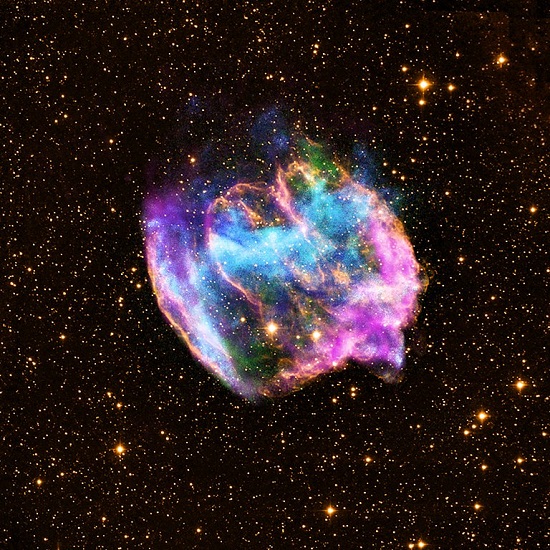As I write this I am on a KLM 777-300 about 30,000 feet over the Sahara Desert – I’m on my way to Cape Town for an international astronomy conference where I’ll be making two presentations. Rather than the normal format of answering questions that are posed, I thought I’d, instead, take a few opportunities to write about radiation and its place in the universe – through the eyes of a radiation safety professional (that would be me) as well as through the eyes of some astronomers. Since I’m not there yet, I can’t give you the latter viewpoint and, of course, I can’t yet talk about the conference. Instead, let me set the stage!
What is radiation?
To an astronomer, radiation is simply the transfer of energy from one place to another – the different types of radiation (alpha, beta, gamma, and so forth) are simply the means by which this energy is transferred. If that energy comes from an unstable atomic nucleus then chances are that it will be carried off by an alpha or beta particle and maybe by a photon (e.g. gamma ray or x-ray) as well. If the extra energy is found in the electrons surrounding an atom then it’s likely to be in the form of a photon – this could be a photon of visible light, a radio-wave photon, a gamma ray, or anything in between, depending on the amount of energy being carried. The bottom line is that radiation reflects energy in motion from one place to another. Radiation with enough energy to cause the sort of biological damage that might one day lead to cancer (ionizing radiation) is just a tiny part this entire spectrum of radiation energies.
How much radiation is there in the universe?
Well…a lot. In the moment of its birth the universe was not just filled with radiation, it held nothing except for radiation. As time passed, the universe expanded and cooled down and the energy began to “freeze” to form matter, but the universe remained dominated by radiation. Some of that matter clumped together to form stars, which give off both ionizing and non-ionizing radiation, and which also spray high-energy particles into space (another form of radiation). And all of space is filled with microwave radiation – what’s left of the sea of radiation accompanying the Big Bang. These microwave photons fill all of space and, while they’re not dangerous, they are radiation.
What affects the amount of radiation in the universe?
On a universal scale, answering that question gets into more details than we really need to tackle here. But it’s more interesting to look at the smaller-scale details. Let’s think about our Sun, which is a pretty typical star. The Sun is hot enough to glow, the same as a piece of metal held in a flame, so it’s giving off radiation in the form of visible light. It’s also giving off lesser amounts of radio wave radiation, thermal radiation, and even some x-rays. But there’s more than that – our Sun is also spewing prodigious amounts of hydrogen into space. Or, rather, because the temperature is so high, the electrons are stripped off the atoms and the Sun is spewing massive amounts of proton and electron radiation into space. From time to time an eruption will shoot more of these into space in the form of solar flares, coronal mass ejections, and so forth.
That’s our Sun; it’s also every single star in the skies, throughout the universe. And when some of the more massive stars reach the end of their lives, they might explode, showering the universe with still more visible light, charged particles, and ionizing photons. Other, as-yet not fully understood processes can take some of these atoms and accelerate them to ridiculously high energies, slinging them across the universe. And, as if that weren’t enough, these massive explosions can also produce radioactive elements that, as they decay away, shoot still more ionizing photons into the void.
What are your presentations about?
In one of my presentations I’ll be going over how natural radiation levels have changed on Earth since the time our planet first formed – I’ll be looking at how radionuclide concentrations in the rocks has changed over time, how the evolution of the Sun and our atmosphere has affected radiation dose from the heavens, how changes in atmospheric oxygen levels has affected the amount of radiation damage to our cells, and more. I’ll also be discussing how the exploding stars (supernovae and gamma ray bursts) might have affected life on Earth as well as life elsewhere in the universe.
My other presentation is somewhat more targeted – I’ve mentioned in other posts that a stable atom can absorb a neutron, becoming radioactive…it turns out that the same thing can happen when it’s a proton that’s absorbed. It turns out that Saturn’s rings are inside one of Saturn’s radiation belts so, in the other presentation my coauthor and I calculated how much radioactivity might be produced in this manner and whether or not it might be dangerous.
And the other presentations?
Well…astronomy is, almost by definition, about the radiation from distant objects and what it can teach us. So a lot of the presentations will be about radiation, but mostly about visible light. Having said that, I’ve already met a high-energy astrophysicist who will be talking about his work (which involves ionizing particles), and I know that there will be talks about supernovae, gamma ray bursts, x-ray and gamma-ray observations, flares around other stars, and much more. I’ll describe some of these in greater detail in my next posts. For now, though – it’s time to get some sleep. I had a seven-hour flight from NYC to Amsterdam, a few hours in Schiphol Airport, and I’m now four hours into an 11-hour flight to Cape Town. Which is to say that I’m tired! Stand by for more, though, over the next week.
